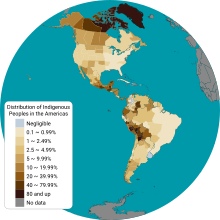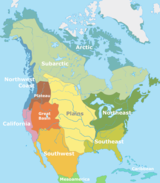Indigenous peoples of the Americas
The Indigenous peoples of the Americas are groups of people native to a specific region that inhabited the Americas before the arrival of European settlers in the 15th century and the ethnic groups who continue to identify themselves with those peoples.[34]
The Indigenous peoples of the Americas are diverse; some Indigenous peoples were historically hunter-gatherers, while others traditionally practice agriculture and aquaculture. In some regions, Indigenous peoples created pre-contact monumental architecture, large-scale organized cities, city-states, chiefdoms, states, kingdoms, republics, confederacies and empires.[35] These societies had varying degrees of knowledge of engineering, architecture, mathematics, astronomy, writing, physics, medicine, planting and irrigation, geology, mining, metallurgy, sculpture and gold smithing.
Many parts of the Americas are still populated by Indigenous peoples; some countries have sizeable populations, especially Bolivia, Canada, Chile, Colombia, Ecuador, Guatemala, Mexico, Peru and the United States. At least a thousand different Indigenous languages are spoken in the Americas, where there are also 574 federally recognized tribes in the United States alone. Several of these languages are recognized as official by several governments such as those in Bolivia, Peru, Paraguay and Greenland. Some, such as Quechua, Arawak, Aymara, Guaraní, Mayan and Nahuatl, count their speakers in the millions. Whether contemporary Indigenous people live in rural communities or urban ones, many also maintain additional aspects of their cultural practices to varying degrees, including religion, social organization and subsistence practices. Like most cultures, over time, cultures specific to many Indigenous peoples have also evolved, preserving traditional customs but also adjusting to meet modern needs. Some Indigenous peoples still live in relative isolation from Western culture and a few are still counted as uncontacted peoples.[36] Indigenous peoples from the Americas have also formed diaspora communities outside the Western Hemisphere, namely in former colonial centers in Europe. A notable example is the sizable Greenlandic Inuit community in Denmark.[37] In the 20th and 21st centuries, Indigenous peoples from Suriname and French Guiana migrated to the Netherlands and France, respectively.[38][39]
Terminology

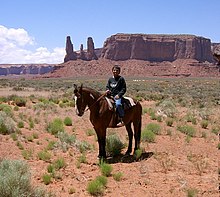
Application of the term "Indian" originated with Christopher Columbus, who, in his search for India, thought that he had arrived in the East Indies.[40][41][42][43][44][45]
The islands came to be known as the "
The term Amerindian, a
"
The Métis people of Canada can be contrasted, for instance, to the Indigenous-European mixed-race
Among
Indigenous peoples of the United States are commonly known as
Name controversy
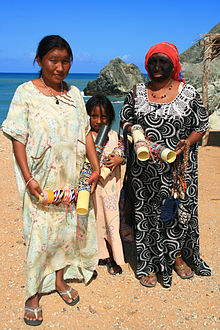
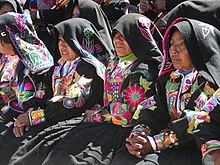
The various nations, tribes, and bands of Indigenous peoples of the Americas have differing preferences in terminology for themselves.[60] While there are regional and generational variations in which umbrella terms are preferred for Indigenous peoples as a whole, in general, most Indigenous peoples prefer to be identified by the name of their specific nation, tribe, or band.[60][61]
Early settlers often adopted terms that some tribes used for each other, not realizing these were derogatory terms used by enemies. When discussing broader subsets of peoples, naming has often been based on shared language, region, or historical relationship.
Since the late 20th century, Indigenous peoples in the Americas have been more vocal about how they want to be addressed, pushing to suppress the use of terms widely considered to be obsolete, inaccurate, or
Since the 1970s, the word "Indigenous", which is capitalized when referring to people, has gradually emerged as a favored umbrella term. The capitalization is to acknowledge that Indigenous peoples have cultures and societies that are equal to Europeans, Africans, and Asians.[61][66] This has recently been acknowledged in the AP Stylebook.[67] Some consider it improper to refer to Indigenous people as "Indigenous Americans" or to append any colonial nationality to the term because Indigenous cultures existed before European colonization. Indigenous groups have territorial claims that are different from modern national and international borders, and when labeled as part of a country, their traditional lands are not acknowledged. Some who have written guidelines consider it more appropriate to describe an Indigenous person as "living in" or "of" the Americas, rather than calling them "American"; or simply calling them "Indigenous" without any addition of a colonial state.[68][69]
History
Peopling of the Americas
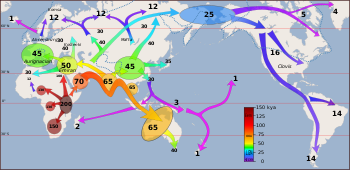
The
While there is general agreement that the Americas were first settled from Asia, the pattern of migration and the place(s) of origin in Eurasia of the peoples who migrated to the Americas remain unclear.
Pre-Columbian era

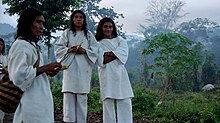
While technically referring to the era before
The Pre-Columbian era refers to all period subdivisions in the history and prehistory of the Americas before the appearance of significant European and African influences on the American continents, spanning the time of the original arrival in the Upper Paleolithic to European colonization during the early modern period.[103] The
According to both Indigenous and European accounts and documents, American civilizations before and at the time of European encounter had achieved great complexity and many accomplishments.[106] For instance, the Aztecs built one of the largest cities in the world, Tenochtitlan (the historical site of what would become Mexico City), with an estimated population of 200,000 for the city proper and a population of close to five million for the extended empire.[107] By comparison, the largest European cities in the 16th century were Constantinople and Paris with 300,000 and 200,000 inhabitants respectively.[108] The population in London, Madrid, and Rome hardly exceeded 50,000 people. In 1523, right around the time of the Spanish conquest, the entire population in the country of England was just under three million people.[109] This fact speaks to the level of sophistication, agriculture, governmental procedure, and rule of law that existed in Tenochtitlan, needed to govern over such a large citizenry. Indigenous civilizations also displayed impressive accomplishments in astronomy and mathematics, including the most accurate calendar in the world.[citation needed] The domestication of maize or corn required thousands of years of selective breeding, and continued cultivation of multiple varieties was done with planning and selection, generally by women.
Inuit, Yupik, Aleut, and Indigenous creation myths tell of a variety of origins of their respective peoples. Some were "always there" or were created by gods or animals, some migrated from a specified compass point, and others came from "across the ocean".[110]
European colonization
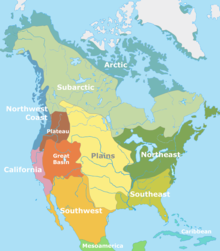
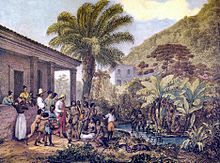
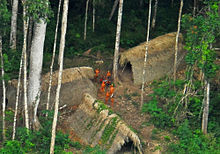
The European colonization of the Americas fundamentally changed the lives and cultures of the resident Indigenous peoples. Although the exact pre-colonization population count of the Americas is unknown, scholars estimate that Indigenous populations diminished by between 80% and 90% during the first centuries of European colonization. Most scholars estimate a pre-colonization population of around 50 million, with other scholars arguing for an estimate of 100 million. Estimates reach as high as 145 million.[111][112][113]
Epidemics ravaged the Americas with diseases, such as smallpox, measles, and cholera, which the early colonists brought from Europe. The spread of infectious diseases was slow initially, as most Europeans were not actively or visibly infected, due to inherited immunity from generations of exposure to these diseases in Europe. This changed when the Europeans began the human trafficking of massive numbers of enslaved Western and Central African people to the Americas. Like Indigenous peoples, these African people, newly exposed to European diseases, lacked any inherited resistance to the diseases of Europe. In 1520 an African who had been infected with smallpox had arrived in Yucatán. By 1558, the disease had spread throughout South America and had arrived at the Plata basin.[114] Colonist violence towards Indigenous peoples accelerated the loss of lives. European colonists perpetrated massacres on the Indigenous peoples and enslaved them.[115][116][117] According to the U.S. Bureau of the Census (1894), the North American Indian Wars of the 19th century had a known death toll of about 19,000 Europeans and 30,000 Native Americans, and an estimated total death toll of 45,000 Native Americans.[118]
The first Indigenous group encountered by Columbus, the 250,000
Following years of mistreatment, the Taínos began to adopt suicidal behaviors, with women aborting or killing their infants and men jumping from cliffs or ingesting untreated cassava, a violent poison.[119] Eventually, a Taíno Cacique named Enriquillo managed to hold out in the Baoruco Mountain Range for thirteen years, causing serious damage to the Spanish, Carib-held plantations and their Indian auxiliaries.[122][failed verification] Hearing of the seriousness of the revolt, Emperor Charles V (also King of Spain) sent Captain Francisco Barrionuevo to negotiate a peace treaty with the ever-increasing number of rebels. Two months later, after consultation with the Audencia of Santo Domingo, Enriquillo was offered any part of the island to live in peace.
The
Epidemic disease was the overwhelming cause of the population decline of the Indigenous peoples.[124][125] After initial contact with Europeans and Africans, Old World diseases caused the deaths of 90 to 95% of the native population of the New World in the following 150 years.[126] Smallpox killed from one-third to half of the native population of Hispaniola in 1518.[127][128] By killing the Incan ruler Huayna Capac, smallpox caused the Inca Civil War of 1529–1532. Smallpox was only the first epidemic. Typhus (probably) in 1546, influenza and smallpox together in 1558, smallpox again in 1589, diphtheria in 1614, and measles in 1618—all ravaged the remains of Inca culture.
Smallpox killed millions of native inhabitants of Mexico.[129][130] Unintentionally introduced at Veracruz with the arrival of Pánfilo de Narváez on 23 April 1520, smallpox ravaged Mexico in the 1520s,[131] possibly killing over 150,000 in Tenochtitlán (the heartland of the Aztec Empire) alone, and aiding in the victory of Hernán Cortés over the Aztec Empire at Tenochtitlan (present-day Mexico City) in 1521.[citation needed][114]
There are many factors as to why Indigenous peoples suffered such immense losses from Afro-Eurasian diseases. Many European diseases, like cow pox, are acquired from domesticated animals that are not indigenous to the Americas. European populations had adapted to these diseases, and built up resistance, over many generations. Many of the European diseases that were brought over to the Americas were diseases, like yellow fever, that were relatively manageable if infected as a child, but were deadly if infected as an adult. Children could often survive the disease, resulting in immunity to the disease for the rest of their lives. But contact with adult populations without this childhood or inherited immunity would result in these diseases proving fatal.[114][132]
Colonization of the Caribbean led to the destruction of the Arawaks of the Lesser Antilles. Their culture was destroyed by 1650. Only 500 had survived by the year 1550, though the bloodlines continued through to the modern populace. In Amazonia, Indigenous societies weathered, and continue to suffer, centuries of colonization and genocide.[133]
Contact with European diseases such as smallpox and measles killed between 50 and 67 percent of the Indigenous population of North America in the first hundred years after the arrival of Europeans.
The Indigenous peoples in Brazil declined from a pre-Columbian high of an estimated three million[143] to some 300,000 in 1997.[dubious ][failed verification][144]
The Spanish Empire and other Europeans re-introduced horses to the Americas. Some of these animals escaped and began to breed and increase their numbers in the wild.[145] The reintroduction of the horse, extinct in the Americas for over 7500 years, had a profound impact on Indigenous cultures in the Great Plains of North America and in the Gran Chaco and Patagonia in South America. By domesticating horses, some tribes had great success: horses enabled them to expand their territories, exchange more goods with neighboring tribes, and more easily capture game, especially bison.
According to Erin McKenna and Scott L. Pratt, the Indigenous population of the Americas was 145 million in the late 15th and by the late 17th century, had been reduced to 15 million due to
Indigenous historical trauma

Indigenous historical trauma (IHT) is the trauma that can accumulate across generations and develop as a result of the historical ramifications of colonization and is linked to mental and physical health hardships and population decline.[146] IHT affects many different people in a multitude of ways because the Indigenous community and their history are diverse.
Many studies (such as Whitbeck et al., 2014;[147] Brockie, 2012; Anastasio et al., 2016;[148] Clark & Winterowd, 2012;[149] Tucker et al., 2016)[150] have evaluated the impact of IHT on health outcomes of Indigenous communities from the United States and Canada. IHT is a difficult term to standardize and measure because of the vast and variable diversity of Indigenous people and their communities. Therefore, it is an arduous task to assign an operational definition and systematically collect data when studying IHT. Many of the studies that incorporate IHT measure it in different ways, making it hard to compile data and review it holistically. This is an important point that provides context for the following studies that attempt to understand the relationship between IHT and potential adverse health impacts.
Some of the methodologies to measure IHT include a "Historical Losses Scale" (HLS), "Historical Losses Associated Symptoms Scale" (HLASS), and residential school ancestry studies.[146]: 23 HLS uses a survey format that includes "12 kinds of historical losses", such as loss of language and loss of land and asks participants how often they think about those losses.[146]: 23 The HLASS includes 12 emotional reactions, and asks participants how they feel when they think about these losses.[146] Lastly, the residential school ancestry studies ask respondents if their parents, grandparents, great-grandparents, or "elders from their community" went to a residential school to understand if family or community history in residential schools is associated with negative health outcomes.[146]: 25 In a comprehensive review of the research literature, Joseph Gone and colleagues[146] compiled and compared outcomes for studies using these IHT measures relative to the health outcomes of Indigenous peoples. The study defined negative health outcomes to include such concepts as anxiety, suicidal ideation, suicide attempts, polysubstance abuse, PTSD, depression, binge eating, anger, and sexual abuse.[146]
The connection between IHT and health conditions is complicated because of the difficult nature of measuring IHT, the unknown directionality of IHT and health outcomes, and because the term Indigenous people used in the various samples comprises a huge population of individuals with drastically different experiences and histories. That being said some studies such as Bombay, Matheson, and Anisman (2014),[151] Elias et al. (2012),[152] and Pearce et al. (2008)[153] found that Indigenous respondents with a connection to residential schools have more negative health outcomes (e.g., suicide ideation, suicide attempts, and depression) than those who did not have a connection to residential schools. Additionally, Indigenous respondents with higher HLS and HLASS scores had one or more negative health outcomes.[146] While there are many studies[148][154][149][155][150] that found an association between IHT and adverse health outcomes, scholars continue to suggest that it remains difficult to understand the impact of IHT. IHT needs to be systematically measured. Indigenous people also need to be understood in separate categories based on similar experiences, location, and background as opposed to being categorized as one monolithic group.[146]
Agriculture


Plants
For thousands of years, Indigenous peoples domesticated, bred, and cultivated a large array of plant species. These species now constitute between 50% and 60% of all crops in cultivation worldwide.
The South American highlands became a center of early agriculture. Genetic testing of the wide variety of cultivars and wild species suggests that the potato has a single origin in the area of southern Peru,[157] from a species in the Solanum brevicaule complex. Over 99% of all modern cultivated potatoes worldwide are descendants of a subspecies Indigenous to south-central Chile,[158] Solanum tuberosum ssp. tuberosum, where it was cultivated as long as 10,000 years ago.[159][160] According to Linda Newson, "It is clear that in pre-Columbian times some groups struggled to survive and often suffered food shortages and famines, while others enjoyed a varied and substantial diet."[161]
Persistent drought around AD 850 coincided with the collapse of the Classic Maya civilization, and the famine of One Rabbit (AD 1454) was a major catastrophe in Mexico.[162]

Indigenous peoples of North America began practicing
In the Mississippi River valley, Europeans noted that Native Americans managed groves of nut and fruit trees not far from villages and towns and their gardens and agricultural fields. They would have used prescribed burning further away, in forest and prairie areas.[164]

Many crops first domesticated by Indigenous peoples are now produced and used globally, most notably
Studies of contemporary Indigenous environmental management—including agro-forestry practices among Itza Maya in Guatemala and hunting and fishing among the Menominee of Wisconsin—suggest that longstanding "sacred values" may represent a summary of sustainable millennial traditions.[166]
Animals
Numerous
The Fuegian dog was a domesticated variation of the culpeo that was raised by several cultures in Tierra del Fuego, like the Selk'nam and the Yahgan.[168] It was exterminated by Argentine and Chilean settlers, due to supposedly posing as a threat to livestock.[169]
Several bird species, such as turkeys, Muscovy ducks, Puna ibis, and neotropic cormorants were domesticated by various peoples in Mesoamerica and South America to be used for poultry.
In the Andean region, indigenous peoples domesticated llamas and alpacas to produce fiber and meat. The llama was the only beast of burden in the Americas before European colonization.
Guinea pigs were domesticated from wild cavies to be raised for meat consumption in the Andean region. Guinea pigs are now widely raised in Western society as household pets.
Culture
Cultural practices in the Americas seem to have been shared mostly within geographical zones where distinct ethnic groups adopt shared cultural traits, similar technologies, and social organizations. An example of such a cultural area is Mesoamerica, where millennia of coexistence and shared development among the peoples of the region produced a fairly homogeneous culture with complex agricultural and social patterns. Another well-known example is the North American plains where until the 19th century several peoples shared the traits of nomadic hunter-gatherers based primarily on buffalo hunting.
Languages

The languages of the North American Indians have been classified into 56 groups or stock tongues, in which the spoken languages of the tribes may be said to center. In connection with speech, reference may be made to gesture language which was highly developed in parts of this area. Of equal interest is the picture writing especially well developed among the Chippewas and Delawares.[170]
Writing systems
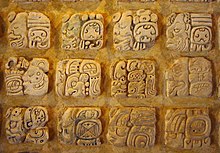
Beginning in the 1st millennium BCE, pre-Columbian cultures in
The
The Zapotec writing system, one of the earliest in the Americas,[175] was logographic and presumably syllabic.[175] There are remnants of Zapotec writing in inscriptions on some of the monumental architecture of the period, but so few inscriptions are extant that it is difficult to fully describe the writing system. The oldest example of the Zapotec script, dating from around 600 BCE, is on a monument that was discovered in San José Mogote.[176]
Spanish mendicants in the sixteenth century taught Indigenous scribes in their communities to write their languages using Latin letters, and there are a large number of local-level documents in Nahuatl, Zapotec, Mixtec, and Yucatec Maya from the colonial era, many of which were part of lawsuits and other legal matters. Although Spaniards initially taught Indigenous scribes alphabetic writing, the tradition became self-perpetuating at the local level.[178] The Spanish crown gathered such documentation, and contemporary Spanish translations were made for legal cases. Scholars have translated and analyzed these documents in what is called the New Philology to write histories of Indigenous peoples from Indigenous viewpoints.[179]
The
Aboriginal syllabic writing, or simply syllabics, is a family of
Music and art

The music of the Indigenous peoples of Central Mexico and Central America, like that of the North American cultures, tends to be spiritual ceremonies. It traditionally includes a large variety of percussion and wind instruments such as drums, flutes, sea shells (used as trumpets), and "rain" tubes. No remnants of pre-Columbian stringed instruments were found until archaeologists discovered a jar in Guatemala, attributed to the Maya of the Late Classic Era (600–900 CE); this jar was decorated with imagery depicting a stringed musical instrument which has since been reproduced. This instrument is one of the very few stringed instruments known in the Americas before the introduction of European musical instruments; when played, it produces a sound that mimics a jaguar's growl.[180]
After the entry of the Spaniards, the process of spiritual conquest was favored, among other things, by the
The solution that was proposed was not to employ but a certain number of indigenous people in the musical service, not to teach them counterpoint, not to allow them to play certain instruments (brass breaths, for example, in Oaxaca, Mexico) and, finally, not to import more instruments so that the indigenous people would not have access to them. The latter was not an obstacle to the musical enjoyment of the natives, who experienced the making of instruments, particularly rubbed strings (violins and double basses) or plucked (third). It is there where we can find the origin of what is now called traditional music whose instruments have their tuning and a typical Western structure.[187]
Demography
The following table provides estimates for each country in the Americas of the populations of Indigenous people and those with partial Indigenous ancestry, each expressed as a percentage of the overall population. The total percentage obtained by adding both of these categories is also given.
Note: these categories are inconsistently defined and measured differently from country to country. Some figures are based on the results of population-wide genetic surveys while others are based on self-identification or observational estimation.
| Country | Indigenous | Ref. | Part Indigenous | Ref. | Combined total | Ref. |
|---|---|---|---|---|---|---|
| 89% | % | 89% | [188] | |||
| 1.8% | 3.6% | 5.4% | [189] | |||
| 7% | 83% | 90% | [190] | |||
| 1.1% | 1.8% | 2.9% | [191] | |||
| % | % | % | ||||
| ~0.4% | ~0% | ~0.4% | [192] | |||
| % | % | % | [193] | |||
| % | % | % | ||||
| 0.4% | [194] | 84% | [195][196] | 84.4% | ||
| % | % | % | ||||
| % | % | % | ||||
| 2% | % | % | [197] | |||
| 0.8% | 88% | 88.8% | ||||
| 2.38% | [198] | 27% | [199][200] | 29.38% | ||
| 20% | 68% | 88% | [201] | |||
| 0.4% | 12% | 12.4% | [202] | |||
| 10.9% | % | % | [203] | |||
| 9.5% | [204] | 50.3% | [204] | 59.8% | [204] | |
| 25% | 65% | 90% | [205] | |||
| % | % | % | ||||
| 10.5% | [206] | % | % | |||
| 1.7% | 95% | 96.7% | [207] | |||
| 25.8% | 60.2% | 86% | [208] | |||
| 2% | [209] | % | % | |||
| 0% | [210] | 2.4% | [211] | 2.4% | ||
| 2.7% | 51.6% | 54.3% | [212] |
History and status by continent and country
North America
Canada

The characteristics of Indigenous culture in Canada included permanent
Greenland

The Greenlandic Inuit (
Approximately 89 percent of Greenland's population of 57,695 is Greenlandic
- the Kalaallit of west Greenland, who speak Kalaallisut
- the Tunumiit oraasiat("East Greenlandic")
- the Inughuit of north Greenland, who speak Inuktun ("Polar Inuit")
Mexico

The territory of modern-day Mexico was home to numerous Indigenous civilizations before the arrival of the Spanish
In contrast to what was the general rule in the rest of North America, the history of the colony of
In the states of
regions of Mexico, Indigenous people are a small minority.The
The Indigenous peoples in Mexico have the right of free determination under the second article of the constitution. According to this article, the Indigenous peoples are granted:[249]

- the right to decide the internal forms of social, economic, political, and cultural organization;
- the right to apply their normative systems of regulation as long as human rights and gender equality are respected;
- the right to preserve and enrich their languages and cultures;
- the right to elect representatives before the municipal council in which their territories are located;
amongst other rights.
United States

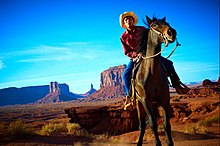
Indigenous peoples in what is now the
The United States has authority over Indigenous
In the 2020 census 2.9% of the U.S. population claimed to have some degree of Native American heritage. When answering a question about racial background, 3.7 million people identified solely as "American Indian or Alaska Native", while another 5.9 million did so in combination with other races.
Some California and Southwestern tribes, such as the
Central America
Belize
Mestizos (mixed European-Indigenous) number about 34% of the population; unmixed
Costa Rica
There are over 114,000 inhabitants of Native American origins, representing 2.4% of the population. Most of them live in secluded reservations, distributed among eight ethnic groups:
These native groups are characterized by their work in wood, like masks, drums, and other artistic figures, as well as fabrics made of cotton.
Their subsistence is based on agriculture, having corn, beans, and plantains as the main crops.[citation needed]
El Salvador

Estimates for El Salvador's indigenous population vary. The last time a reported census had an Indigenous ethnic option was in 2007, which estimated that 0.23% of the population identified as Indigenous.[26] Historically, estimates have claimed higher amounts. A 1930 census stated that 5.6% were Indigenous.[253] By the mid-20th century, there may have been as much as 20% (or 400,000) that would qualify as "Indigenous". Another estimate stated that by the late 1980s, 10% of the population was Indigenous, and another 89% was mestizo (or people of mixed European and Indigenous ancestry).[254]
Much of
Guatemala

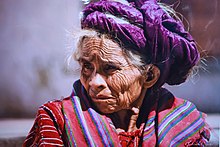
Guatemala has one of the largest Indigenous populations in Central America, with approximately 43.6% of the population considering themselves Indigenous.[255] The Indigenous demographic portion of Guatemala's population consists of a majority of Mayan groups and one non-Mayan group. The Mayan language-speaking portion makes up 29.7% of the population and is distributed into 23 groups namely Q'eqchi' 8.3%, K'iche 7.8%, Mam 4.4%, Kaqchikel 3%, Q'anjob'al 1.2%, Poqomchi' 1%, and Other 4%.[255] The Non-Mayan group consists of the Xinca who are another set of Indigenous people making up 1.8% of the population.[255] Other sources indicate that between 50% and 60% of the population could be Indigenous because part of the Mestizo population is predominantly Indigenous.
The Mayan tribes cover a vast geographic area throughout Central America and expand beyond Guatemala into other countries. One could find vast groups of Mayan people in Boca Costa, in the Southern portions of Guatemala, as well as the Western Highlands living together in close communities.[256] Within these communities and outside of them, around 23 Indigenous languages (or Native American Indigenous languages) are spoken as a first language. Of these 23 languages, they only received official recognition by the Government in 2003 under the Law of National Languages.[255] The Law on National Languages recognizes 23 Indigenous languages including Xinca, enforcing that public and government institutions not only translate but also provide services in said languages.[257] It would provide services in Cakchiquel, Garifuna, Kekchi, Mam, Quiche, and Xinca.[258]
The Law of National Languages has been an effort to grant and protect Indigenous people rights not afforded to them previously. Along with the Law of National Languages passed in 2003, in 1996 the Guatemalan Constitutional Court had ratified the ILO Convention 169 on Indigenous and Tribal Peoples.[259] The ILO Convention 169 on Indigenous and Tribal Peoples, is also known as Convention 169. Which is the only International Law regarding Indigenous peoples that Independent countries can adopt. The convention establishes that governments like Guatemala must consult with Indigenous groups before any projects occur on tribal lands.[260]
Honduras
About 5 percent of the population is of full-blooded Indigenous descent, but as much as 80 percent of Hondurans are
Nicaragua
About 5% of the
Another major Indigenous culture in eastern Nicaragua is the
Other Indigenous groups in Nicaragua are located in the central, northern, and Pacific areas and they are self-identified as follows:
Panama


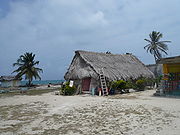
Indigenous peoples of Panama, or Native Panamanians, are the native peoples of Panama. According to the 2010 census, they make up 12.3% of the overall population of 3.4 million, or just over 418,000 people. The Ngäbe and Buglé comprise half of the indigenous peoples of Panama.[264]
Many of the Indigenous Peoples live onSouth America
Argentina

In 2005, the Indigenous population living in Argentina (known as pueblos originarios) numbered about 600,329 (1.6% of the total population); this figure includes 457,363 people who self-identified as belonging to an Indigenous ethnic group and 142,966 who identified themselves as first-generation descendants of an Indigenous people.
Bolivia
This article's factual accuracy may be compromised due to out-of-date information. (April 2012) |

In Bolivia, the 2012 National Census reported that 41% of residents over the age of 15 are of Indigenous origin. Some 3.7% report growing up with an Indigenous mother tongue but do not identify as Indigenous.[267] When both of these categories are totaled, and children under 15, some 66.4% of Bolivia's population was recorded as Indigenous in the 2001 Census.[268]
The 2021 National Census, recognizes 38 cultures, each with its language, as part of a pluri-national state. Some groups, including
The largest Indigenous ethnic groups are
Large numbers of Bolivian highland
Some radio and television programs are produced in the Quechua and Aymara languages. The constitutional reform in 1997 recognized Bolivia as a multi-lingual, pluri-ethnic society and introduced education reform. In 2005, for the first time in the country's history, an Indigenous Aymara, Evo Morales, was elected as president.
Morales began work on his "Indigenous autonomy" policy, which he launched in the eastern lowlands department on 3 August 2009. Bolivia was the first nation in the history of South America to affirm the right of Indigenous people to self-government.[272] Speaking in Santa Cruz Department, the President called it "a historic day for the peasant and Indigenous movement", saying that, though he might make errors, he would "never betray the fight started by our ancestors and the fight of the Bolivian people".[272] A vote on further autonomy for jurisdictions took place in December 2009, at the same time as general elections to office. The issue divided the country.[273]
At that time, Indigenous peoples voted overwhelmingly for more autonomy: five departments that had not already done so voted for it;[274][275] as did Gran Chaco Province in Taríja, for regional autonomy;[276] and 11 of 12 municipalities that had referendums on this issue.[274]
Brazil
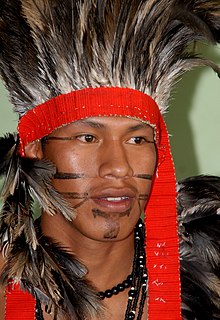
The Washington Post reported in 2007, "As has been proved in the past when uncontacted tribes are introduced to other populations and the microbes they carry, maladies as simple as the common cold can be deadly. In the 1970s, 185 members of the Panara tribe died within two years of discovery after contracting such diseases as flu and chickenpox, leaving only 69 survivors."[278]
Chile


According to the 2012 Census, 10% of the Chilean population, including the
Other groups include the
Colombia
A minority today within
Ecuador
Between 55% and 65% of Ecuador's population consists of Mestizos of mixed indigenous and European ancestry while indigenous people comprise about 25%.. Linguistic evidence suggests that the Salascan and the Saraguro may have been the descendants of Bolivian ethnic groups transplanted to Ecuador as mitimaes.
Coastal groups, including the
In 1986, Indigenous peoples formed the first "truly" national
French Guiana
French Guiana is home to approximately 10,000 indigenous peoples, such as the Kalina and Lokono. Over time, the indigenous population has protested against various environmental issues, such as illegal gold mining, pollution, and a drastic decrease in wild game.
Guyana
During the early stages of colonization, the indigenous peoples in Guyana partook in trade relations with Dutch settlers and assisted in militia services such as hunting down escaped slaves for the British, which continued until the 19th century. Indigenous Guyanese people are responsible for the invention of the canoe as well as Guyanese pepperpot and the foundation of the Alleluia church.
Guyana's indigenous peoples have been recognized under the Constitution of 1965 and comprise 9.16% of the overall population.
Paraguay
The vast majority of indigenous peoples in
Peru
According to the 2017 Census, the Indigenous population in Peru makes up approximately 26%.[5] However, this does not include Mestizos of mixed indigenous and European descent, who make up the majority of the population. Genetic testing indicates that Peruvian Mestizos are of predominantly indigenous ancestry.[284] Indigenous traditions and customs have shaped the way Peruvians live and see themselves today. Cultural citizenship—or what Renato Rosaldo has called, "the right to be different and to belong, in a democratic, participatory sense" (1996:243)—is not yet very well developed in Peru. This is perhaps no more apparent than in the country's Amazonian regions where Indigenous societies continue to struggle against state-sponsored economic abuses, cultural discrimination, and pervasive violence.[285]
Suriname
According to the 2012 census, the indigenous population of Suriname numbers around 20,000, amounting to 3.8% of the population. The most numerous indigenous groups in Suriname primarily comprise the Lokono, Kalina, Tiriyó, and Wayana.
Uruguay
Unlike most other Spanish-speaking countries, indigenous peoples are not a significant element in Uruguay, as the entire indigenous population is virtually extinct, with a few exceptions such as the Guaraní. Approximately 2.4% of the population in Uruguay is reported to have indigenous ancestry.[211]
Venezuela

Most Venezuelans have some degree of indigenous heritage even if they may not identify as such. The 2011 census estimated that around 52% of the population identified as
The 1999 constitution of Venezuela gives indigenous peoples special rights, although the vast majority of them still live in very critical conditions of poverty. The government provides primary education in their languages in public schools to some of the largest groups, in efforts to continue the languages.
Caribbean
The indigenous population of the Caribbean islands consisted of the
Rise of Indigenous movements
| Part of a series on |
| Indigenous rights |
|---|
| Rights |
| Governmental organizations |
| NGOs and political groups |
| Issues |
| Legal representation |
| Countries |
|
| Category |
Since the late 20th century, Indigenous peoples in the Americas have become more politically active in asserting their treaty rights and expanding their influence. Some have organized to achieve some sort of
There has been a recognition of Indigenous movements on an international scale. The membership of the United Nations voted to adopt the Declaration on the Rights of Indigenous Peoples, despite dissent from some of the stronger countries of the Americas.
In Colombia, various Indigenous groups have protested the denial of their rights. People organized a march in Cali in October 2008 to demand the government live up to promises to protect Indigenous lands, defend the Indigenous against violence, and reconsider the free trade pact with the United States.[288]
Indigenous heads of state

The first Indigenous President of the Americas was
The first Indigenous candidate to be democratically elected as head of a country in the Americas was Benito Juárez, a Zapotec Mexican who was elected President of Mexico in 1858 and led the country until 1872 and led the country to victory during the Second French intervention in Mexico.[290]
In 1930
In 2005, Evo Morales of the Aymara people was the first Indigenous candidate elected as president of Bolivia and the first elected in South America.[292]
Genetic research
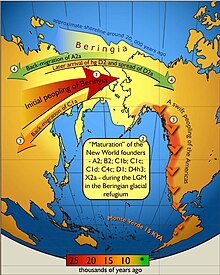


Genetic comparisons of the mitochondrial DNA (mtDNA) and Y-chromosome of Native Americans to that of certain
Some scientific evidence links them to North Asian peoples, specifically the
The common occurrence of the
Available genetic patterns lead to two main theories of genetic episodes affecting the Indigenous peoples of the Americas; first with the initial peopling of the
The most popular theory among anthropologists is the
Multiple recent findings on autosomal DNA and full genome revealed more information about the formation, settlement, and external relationships of the Indigenous peoples of the Americas to other populations. Native Americans are very closely related to the
The date for the formation of the Indigenous peoples of the Americas gene pool ranges from 36,000 to 25,000 years ago, with their internal diverging being around 21,000 years ago, during the settlement of the Americas.
Notable people
See also
- Indigenous peoples in Ecuador
- Indigenous peoples in Paraguay
- Indigenous peoples of Costa Rica
- Indigenous peoples in Argentina
- Indigenous peoples of Peru
- Indigenous peoples in Canada
- Indigenous peoples in Colombia
- Indigenous peoples in Brazil
- Indigenous peoples in Chile
- Languages of Guatemala
- Indigenous languages of the Americas
List of Indigenous peoples
- List of Greenlandic Inuit
- List of Indigenous artists of the Americas
- List of Indigenous peoples of the Americas
- List of Indigenous writers from the Americas
Culture
- Ceramics of Indigenous peoples of the Americas
- Chunkey
- Fully feathered basket
- Indian Mass
- Native American religion
- Pow wow
- Shamanism
Population and demographics
- Child development of the Indigenous peoples of the Americas
- Classification of the Indigenous peoples of the Americas
- Indigenous Movements in the Americas
- Origins of Paleoindians
- Pacific Islander
- Population history of the Indigenous peoples of the Americas
Central and South America
- Indigenous peoples of South America
- List of Mayan languages
- Society in the Spanish Colonial Americas
Caribbean
- Indigenous peoples of the Caribbean
- Indigenous peoples of Guyana
- Indigenous peoples of Suriname
North America
References
- ^ "Censo de Población y Vivienda 2020: Presentación de resultados" (PDF) (in Spanish). Instituto Nacional de Estadística y Geografía. p. 49. Archived (PDF) from the original on 24 January 2022. Retrieved 29 January 2022.
Note: Indigenous population was identified as the total population in households where the head of the household, his or her spouse or any of their ascendants claimed to speak an Indigenous language.
- ^ "Censo de Población y Vivienda 2020: Resultados complementarios" (PDF) (in Spanish). Instituto Nacional de Estadística y Geografía. p. 27. Archived (PDF) from the original on 31 January 2022. Retrieved 30 January 2022. It was estimated that 19.41% of population aged 3 years and older considered themselves to be Indigenous.
- ^ a b "2020: DEC Redistricting Data (PL 94-171)". United States Census Bureau. The American Indian and Alaska Native population of one race was 3.7 million and the two or more races population 5.9 million (excluding Puerto Rico).
- ^ "Principales Resultados del Censo 2018" (PDF) (in Spanish). Instituto Nacional de Estadística. p. 10. Archived (PDF) from the original on 29 April 2021. Retrieved 29 April 2021. Sum of people who identify as Maya (6,207,503) and Xinka (264,167).
- ^ a b "Perú: Perfil Sociodemográfico" (PDF) (in Spanish). Instituto Nacional de Estadística e Informática. p. 214. Archived (PDF) from the original on 11 February 2020. Retrieved 30 April 2021. Sum of people who identify as Quechua (5,176,809), Aimara (548,292), Native or Indigenous from the Amazon (79,266), Ashaninka (55,489), Part of another Indigenous or originary peoples (49,838), Awajun (37,690) and Shipibo Konibo (25,222).
- ^ "Características de la Población – Censo 2012" (PDF) (in Spanish). Instituto Nacional de Estadística. p. 103. Archived (PDF) from the original on 30 April 2021. Retrieved 30 April 2021. Excluding Afro-Bolivians (23,330).
- ^ "Síntesis de Resultados Censo 2017" (PDF) (in Spanish). Instituto Nacional de Estadísticas. p. 16. Archived (PDF) from the original on 13 July 2018. Retrieved 30 April 2021. Excluding Rapa Nui (9,399).
- ^ "Población Indígena de Colombia" (PDF) (in Spanish). Departamento Administrativo Nacional de Estadística. Archived (PDF) from the original on 18 September 2020. Retrieved 1 May 2021.
- ^ "Indigenous identity by Registered or Treaty Indian status: Canada, provinces and territories, census metropolitan areas and census agglomerations with parts". Statistics Canada. 21 September 2022. Archived from the original on 27 September 2022.
- ^ "Censo Demográfico 2022: Identificação étnico-racial da população, por sexo e idade" (PDF) (in Portuguese). Instituto Brasileiro de Geografia e Estatística. Archived (PDF) from the original on 27 December 2023. Retrieved 1 February 2024.
- ^ "Censo Nacional de Población, Hogares y Viviendas 2022: Población indígena o descendiente de pueblos indígenas u originarios" (PDF) (in Spanish). Instituto Nacional de Estadística y Censos (INDEC). Retrieved 7 March 2024.
- ^ "Presentación de Resultados Nacionales" (PDF) (in Spanish). Instituto Nacional de Estadística y Censos. Archived (PDF) from the original on 31 October 2023. Retrieved 30 October 2023.
- ^ "Resultados Población Indígena" (PDF) (in Spanish). Instituto Nacional de Estadística. Archived from the original (PDF) on 23 November 2018. Retrieved 1 May 2021.
- ^ "Población total por grupo poblacional al que pertenece, según total nacional, departamento, área, sexo y grupo de edad" (XLSX). Instituto Nacional de Estadística. Archived from the original on 2 May 2021. Retrieved 2 May 2021. Sum of people who identify as Maya-Chortí (33,256), Lenca (453,672), Misquito (80,007), Nahua (6,339), Pech (6,024), Tolupán (19,033) and Tawahka (2,690).
- ^ "Resultados – Censo de Poblacion y Vivienda 2005" (PDF) (in Spanish). Instituto Nacional de Estadísticas y Censos. p. 184. Archived (PDF) from the original on 3 May 2021. Retrieved 1 May 2021.
- ^ "Distribución de la población indígena, por grupo étnico, en la República de Panamá, según provincia y comarca indígena" (PDF) (in Spanish). Instituto Nacional de Estadística y Censo. Archived (PDF) from the original on 17 June 2021. Retrieved 2 May 2021.
- ^ "Tierra y territorio, fundamentos de vida de los pueblos indígenas, 2012" (PDF) (in Spanish). Dirección General de Estadística, Encuestas y Censos. p. 20. Archived (PDF) from the original on 30 April 2021. Retrieved 30 April 2021.
- ^ "Población indígena por pertenencia a un pueblo indígena, según provincia y sexo". Instituto Nacional de Estadística y Censos. Archived from the original (XLS) on 17 August 2021. Retrieved 2 May 2021.
- ^ "Final 2012 Census Compendium 2" (PDF). Bureau of Statistics. p. 5. Archived (PDF) from the original on 5 January 2021. Retrieved 2 May 2021.
- ^ "Población por sexo y principal ascendencia étnico racial, según departamento". Instituto Nacional de Estadística. Archived from the original (XLS) on 19 January 2022. Retrieved 2 May 2021.
- ^ "Greenland in Figures 2020" (PDF). Statistics Greenland. p. 37. Archived (PDF) from the original on 3 May 2021. Retrieved 3 May 2021. Corresponding to "Born in Greenland".
- ^ "Population and Housing Census 2010" (PDF). Statistical Institute of Belize. p. 20. Archived (PDF) from the original on 5 January 2022. Retrieved 2 May 2021.
- ^ "Demografische en Sociale Karakteristieken en Migratie" (PDF) (in Dutch). Algemeen Bureau voor de Statistiek. p. 46. Archived (PDF) from the original on 3 May 2021. Retrieved 2 May 2021.
- ^ "Puerto Rico: 2010 Summary Population and Housing Characteristics" (PDF). U.S. Census Bureau. p. 90. Archived (PDF) from the original on 31 January 2022. Retrieved 30 January 2022.
- ^ Aupetit, Mathilde. "Les populations indigènes de la Guyane française : une mémoire environnementale essentielle à protéger" (in French). Archived from the original on 3 May 2021. Retrieved 3 May 2021.
- ^ a b "VI Censo de población y V de vivienda 2007" (PDF) (in Spanish). Dirección General de Estadística y Censos. p. 273. Archived from the original (PDF) on 20 December 2019. Retrieved 2 May 2021.
- ^ "Population and Housing Census Report 2012" (PDF). Statistical Office. p. 28. Archived (PDF) from the original on 24 January 2022. Retrieved 30 January 2022.
- ^ "Ethnic Groups by Sex 1991, 2001 and 2011". Central Statistics Office of Dominica. Archived from the original on 30 January 2022. Retrieved 30 January 2022.
- ^ "2011 Population and Housing Census Demographic Report" (PDF). Central Statistical Office. p. 94. Archived (PDF) from the original on 30 December 2021. Retrieved 2 May 2021.
- ^ "2010 Housing and Population Census". The Central Statistical Office of Saint Lucia. Archived from the original on 29 March 2023. Retrieved 12 October 2023. To generate the report follow Population and Housing > Basic Characteristics > Person Variables, select Ethnic group and execute.
- ^ "2011 Population and Housing Census" (PDF). Statistics Division. p. 64. Archived (PDF) from the original on 11 June 2020. Retrieved 10 October 2023.
- ^ "Population and Housing Census 2011" (PDF). Central Statistics Office. Archived (PDF) from the original on 28 September 2021. Retrieved 30 May 2021.
- ^ "Population by Ethnic, Racial or National Group, 2011". Department of Statistics, Ministry of Sustainable Development. Archived from the original on 11 June 2023. Retrieved 29 March 2024.
- ^ "Indigenous Peoples of North America". www.gale.com. Retrieved 17 December 2023.
- ^ Graeber, David and Wengrow, David "The Dawn of Everything, A New History of Humanity" (New York: Farrar, Straus and Giroux, 2001), pp. 346–358
- OCLC 56632601.
- ^ "Greenlanders in Denmark: a Realistic Perspective of a Varied Group". humanityinaction.org. Retrieved 18 December 2023.
- ^ "Migration from French Overseas Departments to Metropolitan France: What we can learn about a state policy from the censuses, 1962–1999". hal.science. Retrieved 18 December 2023.
- ^ "Diasporic Indigeneity: Surinamese Indigenous Identities in the Netherlands" (PDF). munin.uit.no. Retrieved 18 December 2023.
- ISBN 978-0-19-517284-3. Retrieved 3 July 2011.
- ^ Adams, Cecil (25 October 2001). "Does "Indian" derive from Columbus's description of Native Americans as "una gente in Dios"?". The Straight Dope. Archived from the original on 28 June 2011. Retrieved 3 July 2011.
- ^ Zimmer, Ben (12 October 2009). "The Biggest Misnomer of All Time?". VisualThesaurus. Archived from the original on 19 April 2012. Retrieved 3 July 2011.
- ISBN 978-0-395-66921-1.
- ISBN 978-1-877864-97-1.
- ISBN 978-0-8166-2073-9. Retrieved 4 July 2011.
- ^ Grey, CGP (24 November 2019). 'Indian' or 'Native American'? [Reservations, Part 0] (YouTube video). Archived from the original on 21 December 2021. Retrieved 13 August 2022.
- ISBN 978-1-000-34916-0. Archivedfrom the original on 8 July 2023. Retrieved 5 July 2023.
- ^ "Americanists in dispute" (PDF). The New York Times. 22 October 1902. Archived (PDF) from the original on 25 February 2021. Retrieved 14 January 2009.
- ^ "Terminology." Archived 9 December 2012 at the Wayback Machine Survival International. Retrieved 30 March 2012. "Aborigen" Archived 15 December 2022 at the Wayback Machine Diccionario de la Real Academia Española. Retrieved 8 February 2012.
- ^ Reid, Basil. "Tracing Our Amerindian Heritage". www2.sta.uwi.edu. Archived from the original on 16 February 2016. Retrieved 10 February 2016.
- ^ "The Abbreviated History of Barbados". www.barbados.org. Archived from the original on 16 January 2000. Retrieved 10 February 2016.
- ^ Unique Media Design Limited. "diGJamaica :: Amerindian Jamaica". diGJamaica.com. Archived from the original on 23 February 2016. Retrieved 10 February 2016.
- ^ McKay, Celeste (April 2015). "Briefing Note on Terminology". University of Manitoba. Archived from the original on 25 October 2016. Retrieved 2 July 2020.
- ^ Joseph, Bob (21 September 2016). "Indigenous or Aboriginal: Which is correct?". CBC News. Archived from the original on 22 September 2016. Retrieved 28 September 2022.
- Canadian Constitutionrecognizes three groups of Aboriginal people – Indians (First Nations), Métis and Inuit. These separate peoples have unique heritages, languages, cultural practices, and spiritual beliefs
- ^ "Native American, First Nations or Aboriginal? | Druide". www.druide.com. Archived from the original on 3 July 2017. Retrieved 19 May 2017.
- ^ a b c Kesler, Linc (10 February 2020). "Aboriginal Identity & Terminology". Indigenous Foundations. Archived from the original on 24 March 2022. Retrieved 23 March 2022.
- ^ a b "Indigenous Terminology Guide". Queen's University. 2019. Archived from the original on 24 March 2022. Retrieved 23 March 2022.
- ^ "Terminology of First Nations Native, Aboriginal and Indian" (PDF). the Office of the Aboriginal Advisor for Aboriginals. Archived from the original (PDF) on 14 July 2010. Retrieved 11 November 2009.
Native is a word similar in meaning to Aboriginal. Native Peoples or First peoples is a collective term to describe the descendants of the original peoples of North America.
- ^ ISBN 978-1-4000-3205-1.
- ^ a b loprespub (20 May 2020). "Indigenous Peoples: Terminology Guide". HillNotes. Archived from the original on 20 January 2021. Retrieved 10 September 2021.
- ISBN 978-3-11-060969-1.
- ISBN 90-04-07850-9.
- S2CID 146687944.
- ISBN 978-1-4000-3205-1.
- ^ "Why Capitalize "Indigenous"?". SAPIENS. 19 May 2020. Archived from the original on 25 June 2021. Retrieved 25 June 2021.
- ^ "Associated Press Stylebook". www.apstylebook.com. Archived from the original on 16 August 2021. Retrieved 25 June 2021.
- ^ "Indigenous Terminology Guide". www.queensu.ca. Queen's University. Archived from the original on 24 March 2022. Retrieved 25 June 2021.
- ^ "University Of Guelph Brand Guide | Indigenous Peoples". guides.uoguelph.ca. 14 November 2019. Archived from the original on 25 June 2021. Retrieved 25 June 2021.
- ISBN 978-3-8289-0741-6.
- ^ Pringle, Heather (8 March 2017). "What Happens When an Archaeologist Challenges Mainstream Scientific Thinking?". Smithsonian.
- ISBN 978-1-317-34244-1.
- ^ S2CID 36149744. Archived from the original(PDF) on 2 January 2014. Retrieved 5 February 2010.
- ^ Zimmer, Carl (3 January 2018). "In the Bones of a Buried Child, Signs of a Massive Human Migration to the Americas". The New York Times. Retrieved 3 January 2018.
- S2CID 4454580.
- S2CID 247052631.
- ISBN 978-1-119-96424-7.
- ISBN 978-1-4088-1091-0.
- ^ Fitzhugh, Drs. William; Goddard, Ives; Ousley, Steve; Owsley, Doug; Stanford, Dennis. "Paleoamerican". Smithsonian Institution Anthropology Outreach Office. Archived from the original on 5 January 2009. Retrieved 15 January 2009.
- ^ "Atlas of the Human Journey-The Genographic Project". National Geographic Society. 1996–2008. Archived from the original on 1 May 2011. Retrieved 27 January 2017.
- ^ "The peopling of the Americas: Genetic ancestry influences health". Scientific American. Retrieved 8 May 2019.
- S2CID 162243347.
- ^ "68 Responses to "Sea will rise 'to levels of last Ice Age'"". Center for Climate Systems Research, Columbia University. 26 January 2009. Retrieved 17 November 2009.
- ^ a b Null (27 June 2022). "Peopling of the Americas". Proceedings of the National Academy of Sciences of the United States of America. Retrieved 19 December 2022.
- ISBN 978-0-19-538011-8.
- PMID 35442993.
- ^ a b c Yasinski, Emma (2 May 2022). "New Evidence Complicates the Story of the Peopling of the Americas". The Scientist Magazine. Retrieved 19 December 2022.
- S2CID 220697089.
- S2CID 220715918.
- S2CID 220717778.
- OCLC 1031966951.
- OCLC 1238190784.
- OCLC 1102541304.
- ISBN 978-1-315-50987-7.
- ^ Baisas, Laura (16 November 2022). "Scientists still are figuring out how to age the ancient footprints in White Sands National Park". Popular Science. Retrieved 18 September 2023.
- .
- S2CID 239853925.
- ISBN 978-0-8153-0725-9.
- ^ "What Colombia's Kogi people can teach us about the environment". The Guardian. 29 October 2013. Archived from the original on 19 August 2020. Retrieved 11 August 2020.
- ^ "Inca Child Sacrifice Victims Were Drugged". National Geographic News. 29 July 2013. Archived from the original on 4 July 2020. Retrieved 7 August 2020.
- ^ Killgrove, Kristina. "Inside The Last Meals Of Ancient Victims Of Sacrifice And Murder". Forbes. Archived from the original on 7 November 2020. Retrieved 7 August 2020.
- OCLC 20055667.
- ^ "Method and Theory in American Archaeology". Gordon Willey and Philip Phillips. University of Chicago. 1958. Archived from the original on 23 January 2004.
- S2CID 10172918.
- S2CID 4426545.
- OCLC 57511483.
- ^ Drake, Thomas. "1519". English 257: Literature of Western Civilization. University of Idaho. Archived from the original on 27 December 2018. Retrieved 26 December 2018.
- ^ Bucholz, Robert. "Europe in 1500". University of Hawaii. Archived from the original on 25 December 2018. Retrieved 26 December 2018.
- ^ Munro, John. "Medieval Population Dynamics to 1500" (PDF). University of Toronto. Archived (PDF) from the original on 26 December 2018. Retrieved 26 December 2018.
- ISBN 9780804151757.
- ISBN 978-0142002100. Retrieved 7 October 2013.
- ISBN 978-0-19-508557-0.
- ^ ISBN 978-1-44118-375-0.)
{{cite book}}: CS1 maint: location (link) CS1 maint: multiple names: authors list (link - ^ PMID 7529931.
- ^ Martin, Stacie E (2004). "Native Americans". In Dinah Shelton (ed.). Encyclopedia of Genocide and Crimes against Humanity. Macmillan Library Reference. pp. 740–746.
- ISBN 978-0-19-508557-0.
- ISBN 978-0-8061-2074-4.
- ISBN 978-0-8061-2220-5
- ^ a b Espagnols-Indiens: le choc des civilisations" in L'Histoire, n°322, July–August 2007, pp.14–21
- ^ Smallpox Through History. Archived from the original on 29 October 2009.
- ISBN 978-0-313-33272-2. Retrieved 1 July 2010.
- ISBN 978-0-8191-9642-2. Retrieved 1 July 2010.
- ^ "Laws of Burgos, 1512–1513". Faculty.smu.edu. Archived from the original on 6 June 2019. Retrieved 23 May 2010.
- ISBN 978-0-521-62208-0.
- ^ "BBC Smallpox: Eradicating the Scourge". BBC. 5 November 2009. Archived from the original on 7 May 2013. Retrieved 23 May 2010.
- ^ "The Story Of... Smallpox – and other Deadly Eurasian Germs". Pbs.org. Archived from the original on 16 January 2010. Retrieved 23 May 2010.
- ISBN 978-0-8160-6935-4.
- ^ "Africans in bondage: studies in slavery and the slave trade : essays in honor of Philip D. Curtin on the occasion of the twenty-fifth anniversary of African Studies at the University of Wisconsin: Chapter 1: When did smallpox reach the New World (and why does it matter)?". digicoll.library.wisc.edu. Archived from the original on 6 December 2017. Retrieved 5 December 2017.
- ^ "Epidemics". Libby-genealogy.com. 30 April 2009. Archived from the original on 22 July 2013. Retrieved 23 May 2010.
- ^ American plague Archived 15 December 2022 at the Wayback Machine, New Scientist
- ^ "Allempires.info". 17 November 2017. Archived from the original on 17 November 2017.
- ^ "Stacy Goodling, "Effects of European Diseases on the Inhabitants of the New World"". Millersville.edu. Archived from the original on 10 May 2008. Retrieved 23 May 2010.
- ^ See Varese (2004), as reviewed in Dean (2006). [dead link]
- ^ "Aboriginal Distributions 1630 to 1653". Natural Resources Canada. [dead link]
- ^ Koplow, David A. "Smallpox: The Fight to Eradicate a Global Scourge". Ucpress.edu. p. [page needed]. Archived from the original on 7 September 2008. Retrieved 23 February 2011.
- ^ Dutch Children's Disease Kills Thousands of Mohawks Archived 17 December 2007 at the Wayback Machine
- ^ Spaulding, W.B. "Smallpox". The Canadian Encyclopedia. Archived from the original on 8 June 2019. Retrieved 18 August 2019.
- ^ "Iroquois". Fourdir.com. Archived from the original on 6 November 2016. Retrieved 23 May 2010.
{{cite web}}: CS1 maint: unfit URL (link) - ^ Lange, Greg (23 January 2003). "Smallpox epidemic ravages Native Americans on the northwest coast of North America in the 1770s". Historylink.org. Archived from the original on 26 May 2008. Retrieved 23 May 2010.
- PMID 18159275.
- ^ "Mountain Man Plain Indian Fur Trade". Thefurtrapper.com. Archived from the original on 17 March 2011. Retrieved 23 May 2010.
- S2CID 154875430.
- ^ Fineberg, Gail. "500 Years of Brazil's Discovery". Loc.gov. Archived from the original on 5 December 2009. Retrieved 23 May 2010.
- ^ "Brazil urged to protect Indians". BBC News. 30 March 2005. Archived from the original on 17 November 2017. Retrieved 23 May 2010.
- ^ "Ancient Horse (Equus cf. E. complicatus)". The Academy of Natural Sciences, Thomas Jefferson Fossil Collection, Philadelphia. Archived from the original on 29 August 2008.
- ^ .
- PMID 15376814.
- ^ S2CID 7866571.
- ^ ISSN 2161-1912.
- ^
- PMID 24065606.
- from the original on 13 October 2012. Retrieved 10 August 2020.
- PMID 18455054.
- PMID 26213891.
- PMID 23791028.
- ^ ""Native Americans: The First Farmers." AgExporter October 1, 1999". Allbusiness.com. Archived from the original on 29 August 2011. Retrieved 23 May 2010.
- ^ Miller, N (29 January 2008). "Using DNA, scientists hunt for the roots of the modern potato". American Association for the Advancement of Science. Archived from the original on 26 February 2020. Retrieved 10 September 2008.
- from the original on 9 February 2009. Retrieved 19 November 2009.
- ISBN 978-1-85109-421-9.
- ^
ISBN 9780391042063. Retrieved 27 October 2018.
It is clear that in pre-Columbian times some groups struggled to survive and often suffered food shortages and famines, while others enjoyed a varied and substantial diet.
- ^
Gill, Richardson Benedict (2000). "5. Famine and Social Dissolution". The Great Maya Droughts: Water, Life, and Death (revised ed.). Albuquerque: University of New Mexico Press (published 2001). p. 123. ISBN 9780826327741. Retrieved 27 October 2018.
In Tenochtitlan, during the famine of 1 Rabbit in 1454, Moctezuma Ilhuicamina distributed food from the royal granaries to the poor. When the stores ran out, he gave permission for the populace to leave the city to find food elsewhere and people left. The populations of Texcoco, Chalco, Xochimilco, and Tepanecapan also fled their cities. The Maya Lowlands appear to have suffered a famine at the same time, and the cities of Chichen Itza, Mayapan, and Uxmal appear to have been all abandoned simultaneously [...].
- ^ Owen, Wayne (2002). "Chapter 2 (TERRA–2): The History of Native Plant Communities in the South". Southern Forest Resource Assessment Final Report. U.S. Department of Agriculture, Forest Service, Southern Research Station. Archived from the original on 15 May 2008. Retrieved 29 July 2008.
- ISBN 978-0-231-11157-7.
- ^ Michael Pollan, The Omnivore's Dilemma
- ^ Atran, Scott: Medin, Douglas (2010) The Native Mind and the Cultural Construction of Nature, MIT Press.
- (PDF) from the original on 1 June 2023. Retrieved 7 September 2023.
- hdl:11336/25319. Archived from the original(PDF) on 20 December 2016. Retrieved 2 September 2020.
- ^ Orquera, L.; Piana, E. (1999). La vida material y social de los Yámana (in Spanish). Buenos Aires: Editorial Eudeba. pp. 178–180.
- ^ Hammerton, J.A., Peoples of All Nations, Volume 7, London: Educational Book Co., Limited, 17, New Bridge Street, E.C
- ^ Skidmore, Joel (2006). "The Cascajal Block: The Earliest Precolumbian Writing" (PDF). Mesoweb Reports & News. pp. 1–4. Archived (PDF) from the original on 13 September 2009. Retrieved 14 September 2009.
- ISBN 978-0-500-05061-3.
- ISBN 978-0-500-28553-4.
- ^ Kettunen, Harri; Christophe Helmke (2010). Introduction to Maya Hieroglyphs. Wayeb and Leiden University. Archived from the original on 17 June 2007. Retrieved 31 January 2013.
- ^ a b Urcid Javier, 2005; La Escritura zapoteca
- ^ Flannery and Marcus, 2003
- ^ Elizabeth Hill Boone, "Pictorial Documents and Visual Thinking in Postconquest Mexico". p. 158.
- ^ Frances Karttunen, "Nahuatl Literacy", in George A. Collier et al, eds. The Inca and Aztec States, New York: Academic Press 1982, pp. 395–417.
- ^ James Lockhart, The Nahuas After the Conquest, Stanford: Stanford University Press 1992.
- ^ "Music from the Land of the Jaguar". The Princeton Art Museum. 17 April 2004. Archived from the original on 20 April 2015. Retrieved 22 June 2016. (Includes sound sample.) [dead link]
- ^ ""Hair Pipes in Plains Indian Adornment" by John C. Ewers". Sil.si.edu. Archived from the original on 17 December 2017. Retrieved 14 September 2009.
- ^ Buying Alaska Native Art, Federal Trade Commission, Accessed 9/11/14 http://www.consumer.ftc.gov/articles/0177-buying-alaska-native-art Archived 15 December 2022 at the Wayback Machine
- ^ ""National Native Arts And Cultures Foundation" by Native American Rights Fund". Archived from the original on 17 February 2015. Retrieved 17 February 2015.
- ^ [1] Archived 24 September 2015 at the Wayback Machine
- ^ Pogrebin, Robin (21 April 2009). "With Ford Foundation Backing, a New Agency Will Sponsor Native American Arts". The New York Times. Archived from the original on 27 January 2018. Retrieved 9 April 2018.
- ^ "The Myths That Made America" (PDF). Archived (PDF) from the original on 9 October 2022. Retrieved 31 August 2021.
- ^ "Indians, Song, and Dance in the Missions of Northern New Spain" (PDF). Archived (PDF) from the original on 11 October 2021. Retrieved 31 August 2021.
- ^ "The World Factbook — Central Intelligence Agency". cia.gov. Archived from the original on 9 January 2021. Retrieved 9 April 2018.
- ^ "Aboriginal Identity (8), Area of Residence (6), Age Groups (12) and Sex (3) for the Population of Canada, Provinces and Territories, 2006 Census – 20% Sample Data". Statistics Canada. 19 May 2010. Archived from the original on 7 February 2013. Retrieved 11 December 2012.
- ^ "North America: Mexico Archived 12 November 2021 at the Wayback Machine." The World Factbook. US: Central Intelligence Agency.
- ^ Norris, Tina; Vines, Paula L.; Hoeffel, Elizabeth M. (January 2012). "The American Indian and Alaska Native Population: 2010" (PDF). U.S. Census. Archived (PDF) from the original on 5 May 2012. Retrieved 2 June 2010.
- ^ Grenada Archived 9 January 2021 at the Wayback Machine. The World Factbook. Central Intelligence Agency.
- ^ Haiti Archived 19 March 2021 at the Wayback Machine. The World Factbook. Central Intelligence Agency.
- ^ Puerto Rico Archived 5 January 2021 at the Wayback Machine. The World Factbook. Central Intelligence Agency.
- .
- PMID 15693025.
- ^ Suriname Archived 12 August 2022 at the Wayback Machine. The World Factbook. Central Intelligence Agency.
- ^ "Página/12 :: Sociedad :: Lo que el Censo ayuda a visibilizar". www.pagina12.com.ar. Archived from the original on 15 August 2021. Retrieved 15 August 2021.
- ^ "Reference Populations – Geno 2.0 Next Generation." Genographic Project. US: National Geographic Society. 2016. Archived from the original on 7 April 2016.
- ^ "Britannica World Data: Argentina." Britannica Book of the Year (various issues). Encyclopædia Britannica.
- ^ Bolivia Archived 27 September 2021 at the Wayback Machine. The World Factbook. Central Intelligence Agency.
- ^ "População residente, por cor ou raça, segundo a situação do domicílio – Instituto Brasileiro de Geografia e Estatística" (PDF). Archived (PDF) from the original on 14 June 2011. Retrieved 23 May 2010.
- ^ Chile Archived 9 January 2021 at the Wayback Machine. The World Factbook. Central Intelligence Agency.
- ^ a b c Latinobarómetro 2023 Colombia (14 February 2024). "Documents, Results Documents, Colombia; Latinobarómetro 2023".
{{cite web}}: CS1 maint: numeric names: authors list (link) - ^ Ecuador Archived 10 January 2021 at the Wayback Machine. The World Factbook. Central Intelligence Agency.
- ^ Guyana Archived 7 January 2021 at the Wayback Machine. The World Factbook. Central Intelligence Agency.
- ^ Paraguay Archived 31 December 2018 at the Wayback Machine. The World Factbook. Central Intelligence Agency.
- ^ "Perú: Perfil Sociodemográfico" (PDF). Instituto Nacional de Estadística e Informática. p. 214. Archived (PDF) from the original on 11 February 2020. Retrieved 22 September 2018.
- ^ "CIA World Factbook: Suriname". CIA. Archived from the original on 7 January 2021. Retrieved 23 March 2010.
- ^ Uruguay Archived 16 December 2021 at the Wayback Machine. The World Factbook. Central Intelligence Agency.
- ^ a b "Atlas Sociodemografico y de la Desigualdad en Uruguay, 2011: Ancestry" (PDF) (in Spanish). National Institute of Statistics. Archived from the original (PDF) on 13 November 2014.
- ^ "Resultado Básico del XIV Censo Nacional de Población y Vivienda 2011" (PDF). Ine.gov.ve. p. 29. Archived from the original (PDF) on 15 November 2018. Retrieved 18 February 2012.
- ^ "Census Program Data Viewer dashboard". Statistics Canada. 9 February 2022. Retrieved 3 February 2024.
- ^ a b "Terminology of First Nations, Native, Aboriginal and Métis" (PDF). Aboriginal Infant Development Programs of B.C. 2009. Archived from the original (PDF) on July 14, 2010. Retrieved June 26, 2010.
- ^ "Civilization.ca-Gateway to Aboriginal Heritage-Culture". Canadian Museum of Civilization Corporation. Government of Canada. 12 May 2006. Archived from the original on 20 October 2009. Retrieved 18 September 2009.
- ^ "Inuit Circumpolar Council (Canada)-ICC Charter". Inuit Circumpolar Council > ICC Charter and By-laws > ICC Charter. 2007. Archived from the original on 28 September 2007. Retrieved 18 September 2009.
- ^ Todd, Thornton & Collins 2001, p. 10.
- ^ "Words First An Evolving Terminology Relating to Indigenous peoples in Canada". Communications Branch of Indian and Northern Affairs Canada. 2004. Archived from the original on 14 November 2007. Retrieved 26 June 2010.
- ^ Olson & Pappas 1994, p. 213.
- ^ "Indigenous or Aboriginal: Which is correct?". 21 September 2016. Archived from the original on 22 September 2016. Retrieved 19 November 2020.
- ^ McKay, Celeste (April 2015). "Briefing Note on Terminology". University of Manitoba. Archived from the original on 25 October 2016. Retrieved 2 July 2020.
- ^ "Native American, First Nations or Aboriginal? | Druide". www.druide.com. Retrieved 19 May 2017.
- ISBN 978-0-8032-1710-2. Retrieved 3 October 2010.
- ISBN 978-0-19-507445-1. Retrieved 3 October 2010.
- ^ Kalman, Harold; Mills, Edward (30 September 2007). "Architectural History: Early First Nations". The Canadian Encyclopedia (Historica-Dominion). Retrieved 27 November 2013.
- ISBN 978-0-8020-4195-1. Retrieved 3 October 2010.
- ^ "What to Search: Topics-Canadian Genealogy Centre-Library and Archives Canada". Ethno-Cultural and Aboriginal Groups. Government of Canada. 27 May 2009. Archived from the original on 5 July 2009. Retrieved 2 October 2009.
- ^ "Innu Culture 3. Innu-Inuit 'Warfare'". Adrian Tanner Department of Anthropology-Memorial University of Newfoundland. 1999. Archived from the original on 23 August 2011. Retrieved 5 October 2009.
- ^ Government of Canada, Statistics Canada (21 September 2022). "Indigenous identity by Registered or Treaty Indian status: Canada, provinces and territories, census metropolitan areas and census agglomerations with parts". www12.statcan.gc.ca. Retrieved 21 September 2022.
- ^ [Indigenous peoples in Canada: Key results from the 2016 Census]
- ^ 2011 National Household Survey: Indigenous Peoples in Canada: First Nations People, Métis and Inuit
- ^ "Civilization.ca-Gateway to Aboriginal Heritage-object". Canadian Museum of Civilization Corporation. 12 May 2006. Archived from the original on 15 October 2009. Retrieved 2 October 2009.
- ^ "National Aboriginal Day History" (PDF). Indian and Northern Affairs Canada. Retrieved 18 October 2009.
- ^ "National Aboriginal Achievement Award Recipients". National Aboriginal Achievement Foundation. Archived from the original on 11 October 2009. Retrieved 7 October 2009.
- ^ Indigenous peoples in Greenland at the International Work Group for Indigenous Affairs
- ^ "People and Society: Peru." Archived 19 November 2021 at the Wayback Machine CIA – The World Factbook. Retrieved 28 Dec 2011.
- ^ "Inuktitut, Greenlandic." Archived 11 January 2012 at the Wayback Machine Ethnologue. Retrieved 6 Aug 2012.
- PMID 19433783.
- PMID 25254375.
- ^ "Pueblos Indígenas". Atlas de los Pueblos Indígenas de México (in Mexican Spanish). Archived from the original on 30 November 2021. Retrieved 15 January 2022.
- ^ 2015 Mexican Census (Spanish), Archived at the Wayback Machine
- ^ Ley General de Derechos Lingüísticos de los Pueblos Indígenas Archived 11 June 2008 at the Wayback Machine (PDF).
- ^ "Población Indígena, 2010 y 2020 INEGI" (PDF). 2020. Archived (PDF) from the original on 24 January 2022. Retrieved 29 December 2021.
- ^ "Mayas". Secretaría de Cultura/Sistema de Información Cultural (in Spanish). Archived from the original on 29 December 2021. Retrieved 29 December 2021.
- ^ "Ley General de Derechos Lingüísticos de los Pueblos Indígenas (General Law of the Rights of the Indigenous Peoples)" (PDF). CDI México (in Spanish). Archived from the original (PDF) on 25 September 2007. Retrieved 2 October 2007.
- ^ "Kikapúes — Kikaapoa". CDI México. Archived from the original on 24 April 2015. Retrieved 2 October 2007.
- ^ "Aguacatecos, cakchiqueles, ixiles, kekchíes, tecos y quichés". CDI México. Archived from the original on 26 September 2007. Retrieved 2 October 2007.
- ^ "Poblicación de 5 años y más por Entidad Federativa, sexo y grupos lengüa indígena quinquenales de edad, y su distribución según condición de habla indígena y habla española" (PDF). INEGI, México. Archived from the original (PDF) on 2 January 2008. Retrieved 13 December 2007.
- ^ "Constitución Política de los Estados Unidos Mexicanos" (PDF). Archived from the original (PDF) on 2 January 2013. (779 KB). Second article.
- ^ "Education and Programs: Traditional Territories of Alaska Native Cultures". Alaskan Native Heritage Center Museum. Anchorage, AK. Archived from the original on 14 December 2013. Retrieved 8 November 2015.
- ^ Bureau, US Census. "Census Bureau Releases 2020 Census Data for Nearly 1,500 Detailed Race and Ethnicity Groups, Tribes and Villages". Census.gov. Retrieved 29 March 2024.
- ^ "Belize 2000 Housing and Population Census". Belize Central Statistical Office. 2000. Archived from the original on 28 June 2012. Retrieved 30 September 2008.
- ^ "Primer Censo de Población" (PDF). Oficina Nacional del Censo de Población. 1 May 1930. Archived from the original (PDF) on 19 March 2022. Retrieved 17 March 2022.
- PMID 19724647.
- ^ a b c d "The World Factbook – Central Intelligence Agency". Cia.gov. Archived from the original on 16 April 2021. Retrieved 18 October 2021.
- ^ Refugees, United Nations High Commissioner for. "Refworld | World Directory of Minorities and Indigenous Peoples – Guatemala : Maya". Refworld. Archived from the original on 7 November 2017. Retrieved 5 November 2017.
- ^ "GUATEMALA: New Law Recognises Indigenous Languages | Inter Press Service". Ipsnews.net. 30 May 2003. Archived from the original on 7 November 2017. Retrieved 5 November 2017.
- ^ "The World Factbook — Central Intelligence Agency". Cia.gov. Archived from the original on 16 April 2021. Retrieved 5 November 2017.
- ^ International, Survival. "Guatemala adopts indigenous rights into Constitution". Archived from the original on 7 November 2017. Retrieved 5 November 2017.
- ^ "Convention C169 – Indigenous and Tribal Peoples Convention, 1989 (No. 169)". Ilo.org. Archived from the original on 29 September 2020. Retrieved 5 November 2017.
- ^ JSTOR 3033029.
- ^ Gould, J. L. (1998). To die in this way: Nicaraguan Indians and the myth of mestizaje, 1880–1965. Duke University Press.
- ^ Saballos, Francisco (10 August 2011). "Características Socioculturales de los Pueblos Indígenas del Pacífico, Centro y Norte" [Sociocultural Characteristics of the Indigenous Peoples of the Pacific, Central and North] (in Spanish). Archived from the original on 14 November 2012. Retrieved 29 January 2018.
- ^ "Panama History: Indigenous People." Archived 2010-11-25 at the Wayback Machine Panama Experts. (retrieved 23 Feb 2011)
- ^ "Indigenous Peoples in Panama." Archived 2011-03-02 at the Wayback Machine International Work Group for Indian Affairs. (retrieved 23 Feb 2011)
- ^ "Encuesta Complementaria de Pueblos Indígenas (ECPI) 2004 – 2005". INDEC. Archived from the original on 11 June 2008. Retrieved 3 December 2013.
- ^ Indigenous identification was treated in a complex way in the 2001 Census, which collected data based on three criteria: self-identification, capacity to speak an indigenous language, and learning an indigenous language as a child. CEPAL, "Los pueblos indígenas de Bolivia: diagnóstico sociodemográfico a partir del censo del 2001 Archived 30 July 2013 at the Wayback Machine", 2005, p. 32
- ^ CEPAL, "Los pueblos indígenas de Bolivia: diagnóstico sociodemográfico a partir del censo del 2001 Archived 30 July 2013 at the Wayback Machine", 2005, p. 42
- ^ CEPAL, "Los pueblos indígenas de Bolivia: diagnóstico sociodemográfico a partir del censo del 2001 Archived 30 July 2013 at the Wayback Machine", 2005, p. 47
- ISBN 978-0-8223-4049-2.
- ^ Rivera Cusicanqui, Silvia (1987). Oppressed but Not Defeated: Peasant Struggles among the Aymara and Qhechwa in Bolivia, 1900–1980. Geneva: United Nations Research Institute for Social Development.
- ^ a b "Bolivian president Morales launches the "indigenous autonomy"". MercoPress. 3 August 2009. Archived from the original on 11 September 2015. Retrieved 5 August 2009.
- ^ "Bolivian Indians in historic step". BBC. 3 August 2009. Archived from the original on 5 August 2009. Retrieved 5 August 2009.
- ^ a b Diego Andrés Chávez Rodríguez, "La Autonomía Indígena Originario Campesina: Entre la formalidad y la autodeterminación", Diálogos en Democracia, 21 March 2010 (Supplement to Pulso Bolivia).
- ^ "La Bolivia autonómica", Los Tiempos (Cochabamba), edición especial, 6 August 2010
- ^ Ministerio de Autonomías, "Región Autónoma Chaco Tarijeño Archived 28 April 2011 at the Wayback Machine."
- ^ a b Colitt, Raymond (1 February 2011). "Uncontacted Amazonian Tribe Spotted in Rare Photos: Big Pics h". Discovery.com. Archived from the original on 2 February 2012. Retrieved 12 February 2012.
- ^ "In Amazonia, Defending the Hidden Tribes" Archived 18 October 2018 at the Wayback Machine, The Washington Post, 8 July 2007.
- ^ "El gradiente sociogenético chileno y sus implicaciones ético-sociales". Medwave.cl. 15 June 2000. Archived from the original on 18 August 2013. Retrieved 23 May 2010.
- ^ DANE 2018 national census
- ^ "Health equity and ethnic minorities in emergency situations", Pier Paolo Balladelli, José Milton Guzmán, Marcelo Korc, Paula Moreno, Gabriel Rivera, The Commission on Social Health Determinants, Pan American Health Organization, World Health Organization, Bogotá, Colombia, 2007
- ^ Encyclopedia of the World's Minorities (2013), p. 422. Edited by Carl Skutsch
- PMID 31239502.
- ^ "Study of short Peruvians reveals new gene with a major impact on height". Science | AAAS. 16 May 2018. Archived from the original on 17 July 2022. Retrieved 30 June 2022.
- ^ Marcheco, Beatriz. "Cuba Indígena hoy: sus rostros y ADN". Agencia Española de Cooperación Internacional para el Desarrollo. p. 75. Archived from the original on 10 October 2023. Retrieved 9 October 2023.
- ^ Stokes, Anne V.; Keegan, William F. (April 1993). "A SETTLEMENT SURVEY FOR PREHISTORIC ARCHAEOLOGICAL SITES ON GRAND CAYMAN". Florida Museum of Natural History, Gainesville. Archived from the original on 17 December 2012. Retrieved 5 January 2013.
- ^ "Home". Reuters. Archived from the original on 27 October 2008.
- ^ "La historia de José Maria, el único presidente indígena de Colombia". El Tiempo (in Spanish). 14 January 2022. Archived from the original on 20 October 2023. Retrieved 11 September 2023.
- ISBN 978-1-84813-523-9.
- ^ James Fred Rippy; Alva Curtis Wilgus (1935). Argentina, Brazil and Chile Since Independence. The George Washington University Press. p. 481.
- ^ Albro, Robert (22 November 2019). "Evo Morales's Chaotic Departure Won't Define His Legacy". Foreign Policy. Archived from the original on 31 July 2021. Retrieved 15 August 2021.
- S2CID 218710761.
- PMID 23782551.
- PMID 11827954.
- ^ ISBN 978-0-7167-3771-1. Archivedfrom the original on 20 January 2022. Retrieved 1 September 2017.
- Quoting: "'Our results show that of all previously studied Asian peoples it isthe peoples living between Altai and Lake Baikal along the Sayan mountains that are genetically closest to Amerindians' – says I.A. Zakharo"
- ISBN 978-0-9721349-1-0.
- ^ Genetic Literacy Project. Archivedfrom the original on 23 November 2021. Retrieved 7 September 2021.
- ^ a b Carey, Teresa L. (9 May 2019). "DNA tests stand on shaky ground to define Native American identity". National Human Genome Research Institute. Archived from the original on 11 January 2022. Retrieved 7 September 2021.
- ^ (PDF) from the original on 26 June 2020. Retrieved 13 May 2015.
- PMID 15638829.
- ]
- ^ a b Tymchuk, Wendy (2008). "Learn about Y-DNA Haplogroup Q. Genebase Tutorials". Genebase Systems. Archived from the original (Verbal tutorial possible) on 22 June 2010. Retrieved 21 November 2009.
- S2CID 4939632.
- ISBN 978-0-8129-7146-0. Retrieved 21 November 2009.
- ^ Jennifer Viegas. "First Americans Endured 20,000-Year Layover". Discovery Channel. Archived from the original on 10 October 2012. Retrieved 18 November 2009. page 2 Archived 13 March 2012 at the Wayback Machine
- ^ Than, Ker (2008). "New World Settlers Took 20,000-Year Pit Stop". National Geographic Society. Archived from the original on 26 August 2014. Retrieved 23 January 2010.
- ^ "Summary of knowledge on the subclades of haplogroup Q". Genebase Systems. 2009. Archived from the original on 10 May 2011. Retrieved 22 November 2009.
- PMID 9811914.
- PMID 14595095.
- PMID 10924403.
- JSTOR 25064865.
- PMID 1346260.
- PMID 24256729.
- from the original on 26 January 2023. Retrieved 26 January 2023.
- PMID 11543902.
- ^ "DNA reveals Native American presence in Polynesia centuries before Europeans arrived". History. Archived from the original on 6 February 2021. Retrieved 26 January 2023.
- PMID 30415837.
Our finding of no excess allele sharing with non-Native American populations in the ancient samples is also striking as many of these individuals—including those at Lapa do Santo—have a "Paleoamerican" cranial morphology that has been suggested to be evidence of the spread of a substructured population of at least two different Native American source populations from Asia to the Americas (von Cramon-Taubadel et al., 2017). Our finding that early Holocene individuals with such a morphology are consistent with deriving all their ancestry from the same homogeneous ancestral population as other Native Americans extends the finding of Raghavan et al., 2015 who came to a similar conclusion after analyzing Native Americans inferred to have Paleoamerican morphology who lived within the last millennium.
- from the original on 12 September 2021. Retrieved 15 September 2021.
It is now evident that the initial dispersal involved the movement from northeast Asia. The first peoples, once south of the continental ice sheets, spread widely, expanded rapidly and branched into multiple populations. Their descendants—over the next fifteen millennia—experienced varying degrees of isolation, admixture, continuity and replacement, and their genomes help to illuminate the relationships among major subgroups of Native American populations. Notably, all ancient individuals in the Americas, save for later-arriving Arctic peoples, are more closely related to contemporary Indigenous American individuals than to any other population elsewhere, which challenges the claim—which is based on anatomical evidence—that there was an early, non-Native American population in the Americas.
- ^ PhD, Anjali A. Sarkar (18 June 2021). "Ancient Human Genomes Reveal Peopling of the Americas". GEN – Genetic Engineering and Biotechnology News. Archived from the original on 15 September 2021. Retrieved 26 January 2023.
The team discovered that the Spirit Cave remains came from a Native American while dismissing a longstanding theory that a group called Paleoamericans existed in North America before Native Americans.
- from the original on 14 January 2023. Retrieved 26 January 2023.
- from the original on 28 September 2022. Retrieved 15 September 2021.
- ^ Sapiens (8 February 2022). "A Genetic Chronicle of the First Peoples in the Americas". SAPIENS. Archived from the original on 27 October 2022. Retrieved 3 April 2023.
- ^ Chen, Stephen (10 May 2023). "Gene study points to link between Stone Age China and the Americas". South China Morning Post. Archived from the original on 11 May 2023. Retrieved 11 May 2023.
Sources
Journal articles
- Gaskins, S. (1999). "Children's daily lives in a Mayan village: A case study of culturally constructed roles and activities". Children's Engagement in the World: Sociocultural Perspectives: 25–61.
- Nimmo, J. (2008). "Young children's access to real life: An examination of the growing boundaries between children in child care and adults in the community". Contemporary Issues in Early Childhood. 9 (1): 3–13. S2CID 144208459.
- Morelli, G.; Rogoff, B.; Angelillo, C. (2003). "Cultural variation in young children's access to work or involvement in specialised child-focused activities". International Journal of Behavioral Development. 27 (3): 264–274. S2CID 145563973.
- Woodhead, M. (1998). Children's perspectives on their working lives: A participatory study in Bangladesh, Ethiopia, the Philippines, Guatemala, El Salvador and Nicaragua.
- Rogoff, B.; Morelli, G. A.; Chavajay, P. (2010). "Children's Integration in Communities and Segregation From People of Differing Ages". Perspectives on Psychological Science. 5 (4): 431–440. S2CID 1391080.
- Gaskins, S. (2006). 13 The Cultural Organization of Yucatec Mayan Children's Social Interactions. Peer relationships in cultural context, 283.
Books
- Barnes, Ian (2015). The Historical Atlas of Native Americans. New York: Chartwell Books. ISBN 978-0-7858-3145-7.
- König, Eva (2002). Indianer 1858-1928, Photographische Reisen von Alaska bis Feuerland. Museum für Volkerkunde Hamburg: Edition Braus. ISBN 978-3-89904-021-0.
- Cappel, Constance (2007). The Smallpox Genocide of the Odawa Tribe at OCLC 175217515.
- Cappel, Constance, ed. (2006). Odawa Language and Legends: Andrew J. Blackbird and Raymond Kiogima. Xlibris. ]
- OCLC 35029491.
- Dean, Bartholomew (2002). "State Power and Indigenous Peoples in Peruvian Amazonia: A Lost Decade, 1990–2000". In OCLC 427474742.
- Dean, Bartholomew; Levi, Jerome M. (2003). At the Risk of Being Heard: Identity, Indigenous Rights, and Postcolonial States. Ann Arbor: OCLC 50841012.
- Dean, Bartholomew (January 2006). "Salt of the Mountain: Campa Asháninka History and Resistance in the Peruvian Jungle (review)". The Americas. 62 (3): 464–466. from the original on 6 November 2011. Retrieved 14 September 2009.
- Josephy, Alvin M. Jr. (1995). 500 Nations: An Illustrated History of North American Indians. London: Hutchinson/Pimlico. ISBN 0-09-179148-0.
- Kane, Katie (1999). "Nits Make Lice: Drogheda, Sand Creek, and the Poetics of Colonial Extermination". Cultural Critique. 42 (42): 81–103. JSTOR 1354592.
- Krech, Shepard III (1999). The Ecological Indian: Myth and History. New York: OCLC 318358852.
- Olson, James Stuart; Pappas, Nicholas Charles (1994). An Ethnohistorical dictionary of the Russian and Soviet empires. Connecticut Greenwood Press. ISBN 978-0-313-27497-8.
- Todd, Roy; Thornton, Martin; Collins, D. N. (2001). Aboriginal people and other Canadians: shaping new relationships. University of Ottawa Press. ISBN 978-0-7766-0541-8.
- Varese, Stefano; OCLC 76909908.
Further reading
- Hamilton, Charles, ed. (1972) [1950 (The Macmillan Company printing)]. Cry of the Thunderbird: The American Indian's Own Story. The Civilization of the American Indian Series Vol. 119. Norman, Oklahoma: University of Oklahoma Press. OCLC 483932822.
External links
- America's Stone Age Explorers, from Nova
- A History of the Native People of Canada from the Canadian Museum of Civilization
- Indigenous Peoples in Brazil from the Instituto Socioambiental (ISA)
- Official website of the National Museum of the American Indian, part of the Smithsonian Institution
- Chamberlain, Alexander Francis (1911). . Encyclopædia Britannica (11th ed.).

